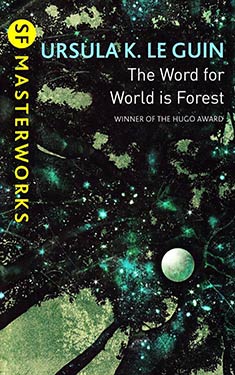Ursula Le
Guin
Completed 5/27/2019,
Reviewed 5/27/2019
3 stars
Completed 12/23/2023, Reviewed 12/28/2023
4 stars (revised - see update at the bottom)
I must not
have in been in the right head space to read this novella. I didn’t find it as praiseworthy as many
other reviewers have. And it won the
Hugo for best novella in the early seventies.
I liked the messages of ecological exploitation, colonialism, and militarism. These messages are still as relevant today as
they were back when it was first written. However, I thought the execution was heavy
handed and the morality was awfully black and white for Le Guin.
 The story is
part of the Hainish Cycle, that is, the collection of novels and novellas that
take place in the same universe where the Hainish civilization seeded the Earth
and other planets, and the ansible is an instantaneous communication device
across the galaxy. This one takes place
on the planet Athshe. It’s a mostly
water covered planet with several large islands forming an archipelago. The islands are covered in forests and the
home to several million Athsheans. The
Athsheans look like green Ewoks. In
fact, it is speculated that George Lucas stole his idea for them from this
book. Even one of their cities is called
Endtor, as in Endor, the moon on which the Ewoks lived. But enough of that.
The story is
part of the Hainish Cycle, that is, the collection of novels and novellas that
take place in the same universe where the Hainish civilization seeded the Earth
and other planets, and the ansible is an instantaneous communication device
across the galaxy. This one takes place
on the planet Athshe. It’s a mostly
water covered planet with several large islands forming an archipelago. The islands are covered in forests and the
home to several million Athsheans. The
Athsheans look like green Ewoks. In
fact, it is speculated that George Lucas stole his idea for them from this
book. Even one of their cities is called
Endtor, as in Endor, the moon on which the Ewoks lived. But enough of that.
Athshe has
been colonized by Terrans for wood harvesting and soybean farm development
under the auspices of the military. The
Terrans have enslaved several thousand Athsheans for menial work, although they
are called a volunteer labor force. The
Terrans considered them lazy, but in reality, the Athsheans were often in a dream
state, a highly significant state of being for them. Things are relatively copacetic until Captain
Davidson rapes and kills one of the female Athsheans, the wife of Selver. Now introduced to the previously unfamiliar
concept of murder, Selver launches an attack on the colony and things escalate
from there.
I thought
the characters were all rather one dimensional.
There’s definitely good guys and bad guys. And even though we spend a lot of time in their
heads, they don’t come across as fully realized beings. Selver comes closest to being
multidimensional, as does Dr. Lyubov, who studies the Athsheans and worked with
Selver to create a translation dictionary.
Captain Davidson is the worst. He’s
basically crazy, operating on an us versus them mentality and them aren’t
humans so they can’t possibly be worth anything. He’s the hardest to take because there is no moral
ambiguity. He’s simply bad and everything
that’s wrong with the military-industrial complex.
I was really
surprised I didn’t care for this book more. It’s well written. As always, the prose is really wonderful. It’s lush without being flowery. The world building is great for such a short
book. And the topics it covers are right
up my alley, especially the ecological aspect.
I just really didn’t care for the characters. I give this book three stars out of
five. It’s average, not a bad read, not
a great read. But for a Le Guin tale, a
bit of a disappointment.
_______________________________
This is an update to my review after giving it a reread for Book Club. I liked it much more this time through. I think I was in the right head space for something more serious. Everything I liked about it last time still holds. And I still think the bad guy was still one dimensional. However, the impact of the themes of ecology, slavery, and abuse all jived with me. And Davidson, the bad military captain, reminded me of Kilgore in Apocalypse Now, the commander who says, “I love the smell of Napalm in the morning.” Yes, this is basically a morality play, but it is powerful. It reminds us of all the things that were wrong with the Viet Nam war, and should be a lesson for the present and the future.
No comments:
Post a Comment